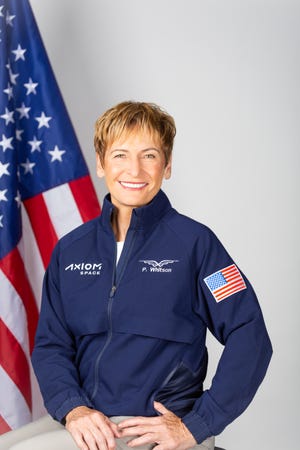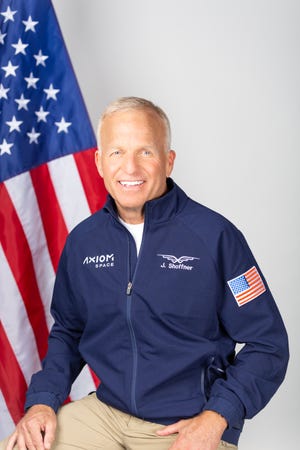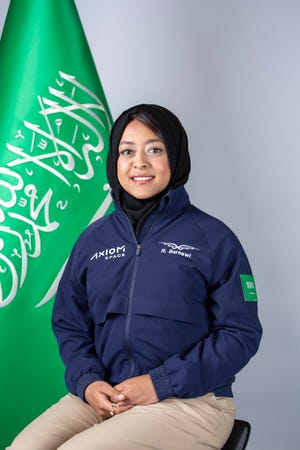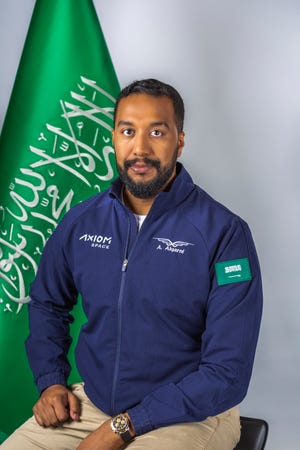Axiom-2, SpaceX’s second private space mission to the International Space Station for Axiom Space and NASA, is set to launch this weekend aboard a SpaceX Falcon 9 and Dragon capsule.
During Monday’s lengthy flight readiness review, heads of the three companies gathered to ensure the aircraft hardware, four-person crew and launch and landing sites are ready to support the 10-day mission. Liftoff from Kennedy Space Center’s Pad 39A is set for Sunday, May 21 at 5:37 PM EDT.
“Today we had a review where we brought together board members from Axiom Space, SpaceX and NASA to talk about the upcoming mission, and at the end of that review, the entire team voted ‘Go,'” Ken Bowersachs, NASA’s associate administrator for space operations, said during a press conference Monday. .
A weather report from the Space Force for the launch is expected on Thursday or Friday.
Meet the crew of Axiom-2:Two Saudi astronauts are set to fly with SpaceX on the next private space mission to the ISS
SpaceX Falcon 9 Launch:More Starlink satellites entered orbit last week
What to know about the Axiom-2 mission?
Former NASA astronaut Peggy Whitson Axiom-2’s commander and attached to the private space shuttle John Shofner and government-sponsored Saudi Arabian astronauts Ali Alkarni and Rayana Barnawi. The mission is under contract between NASA and Houston-based Axiom Space.
“The Dragon vehicle is finished in a hangar waiting to be attached to the (Falcon 9) rocket, and the rocket is ready to fly, (and) the pad is ready,” said William Gerstenmaier, SpaceX’s vice president of flight reliability. “Friday we have a dry suit and steady fire. We have the crew fully trained; they are ready to fly the Dragon capsule to the station, and now they are ready to return to Earth.”
Spectators can expect a sonic boom minutes after liftoff as SpaceX, with a crewed mission for the first time, aims to land the booster at Landing Zone 1 at the Cape Canaveral Space Force Station. For previous human spaceflights, SpaceX has landed its boosters aboard a drone docked in the Atlantic Ocean.
Rocket Launch Schedule:Upcoming Florida launches and landings
“Before we had this kind of capability, we weren’t sure we’d ever get the performance, but the number of Falcons we flew allowed us to say the performance is there and we can use it,” Gerstenmaier said. “It’s going to be consistent with every team going forward, and that’s our plan.”
After launch, the four-person crew will spend about a day in orbit, hold the International Space Station, and spend eight days experiencing what it’s like to work and live in orbit. They then return to make a splashdown landing in the Atlantic Ocean or Gulf of Mexico.
While in orbit, the multinational team will conduct up to 20 experiments and technology demonstrations, with a heavy focus on education. According to Axiom’s report, this includes “a student art competition from space, educational tools, and engaging in student-led projects with universities like MIT.”
When is docking and backup launch opportunity?
If Falcon 9 launches on Sunday, Crew Dragon should arrive at the ISS at 9:30 a.m. EDT on Monday, May 22.
Joel Montalbano, manager of NASA’s International Space Station program, said: “We’re looking at May 21st, and if it’s not (launched) by the 22nd, we’ll stop and focus on the Axiom-2 program. The SpaceX CRS-28 mission,” SpaceX’s next station cargo resupply mission in June 3 scheduled to fly from KSC before Saturday.
If the teams stop this weekend, a future launch date for the Axiom-2 mission must be determined to best fit a busy summer at the station, including the first crewed flight demonstration of the Boeing Starliner capsule in July and NASA’s Crew-7 mission with SpaceX later.
Meet the Axiom-2 private astronauts
Whitson is the first woman to command a private space shuttle and the only member of the four-person crew with previous spaceflight experience. He is a spaceflight veteran and, at 665 days, holds the record for the most time spent in space by any American astronaut. They were collected during three long-duration missions with NASA.

“Space is really changing right now, and I’m really excited to be a part of expanding humanity’s access to this amazing frontier,” Whitson said at a pre-launch press conference last month. “I feel very blessed to have a very talented crew that not only meets the training requirements for this job, but goes above and beyond.”
After retiring from NASA in 2018, he joined Axiom Space as director of human spaceflight. To prepare for private missions to space, he trained as a backup commander for the Axiom-1 mission, which launched last year and was commanded by Axiom’s vice president of business development and chief astronaut. Michael Lopez-Alegria. He is also a former NASA astronaut.
John Shofner is the only private spaceflight participant to have paid for a seat on the Axiom-2 mission. He is an entrepreneur, pilot and STEM advocate who was born in Alaska and currently lives in Knoxville, Tennessee. He is a veteran pilot with over 25 years and over 8,500 hours of flying experience and will fill the role of private mission pilot.

For last year’s Axiom-1 mission, three private spaceflight participants paid $55 million per seat. On Monday, Derek Hassmann, Axiom’s head of mission coordination and operations, said “the cost of sending humans and payloads into space is dynamic and complex,” and did not disclose how much Shofner paid for the flight.
Ali Alkarni and Rayyana Barnawi, the second and third Saudi citizens to fly into space and the first to visit the ISS, were the first government-sponsored astronauts to fly on a private Axiom mission to the ISS.

Barnawi, Saudi’s first female astronaut, is a cancer research laboratory technician. Alkarni is a captain and fighter pilot with 12 years of experience in the Saudi Air Force.
“Ali, as a military pilot, brings a lot of functional and enthusiastic discipline to the job, and he’s always up for extra tests,” Whitson said last month. “Rayanna was the first Saudi woman to fly in space, so obviously, she plays an important role as a role model, but her scientific background in breast cancer and stem cell research is really important to a lot of the research we’re going to conduct during the mission.”

Alkarni and Barnawi are members of the Saudi Space Agency’s National Astronaut Program — unlike Sultan bin Salman Al Saud, who was the first Saudi citizen to fly into space in 1985 aboard NASA’s Discovery space shuttle. Arabia and the first government-sponsored astronauts flew on the Axiom mission.
“This mission is the second in our series of daring missions to the International Space Station,” Axiom Space President and CEO Michael Saffredini said last month. “These are really the steps for us and the process of getting ready to build our space station.”
Axiom Space hopes to launch the first module to dock with the ISS late next year. Followed by another and, finally, a power and cooling system. Before NASA retires the ISS in 2030, the multi-module Axiom station is planned to become a free-flying commercial space station.
“We will be able to work efficiently with NASA and work toward a seamless transition from the International Space Station to the Axiom space station when the ISS retires,” Suffredini said.
Another midnight SpaceX Starlink launch from Pad 40 at the Cape Canaveral Space Force Station is expected later this week, before Sunday’s Axiom-2 launch. The liftoff is set to take place between midnight and 4am on Friday, May 19.
For latest information, visit floridatoday.com/launchschedule. Catch Florida Today’s live launch coverage at https://www.floridatoday.com/space/ beginning 90 minutes before liftoff.
Follow Jamie Groh by contacting him at [email protected] Twitter at @AlteredJamie.
Beginning Sunday, May 21:
- Company/Agency: SpaceX for NASA and Axiom Space
- Rocket: SpaceX Falcon 9
- Location: Launch Complex 39A at Kennedy Space Center
- Release Time: 5:37 PM EDT
- Route: Northeast
- Weather: TBD
- Landing: Landing Zone 1 at the Cape Canaveral Space Force Station
- Live Streaming: Starts 90 minutes before departure at floridatoday.com/space
- About: SpaceX, under contract with Axiom Space, will launch NASA’s second private space flight to the International Space Station. Former NASA astronaut Peggy Whitson, who will lead the mission as commander, and private astronaut John Shofner, the pilot of Axiom-2, are joined by mission specialists Ali Alkarni and Rayana Barnawi, the second and third Saudi citizens to fly into space. He first visited the ISS for a 10-day mission to the orbiting laboratory.

“Friend of animals everywhere. Devoted analyst. Total alcohol scholar. Infuriatingly humble food trailblazer.”